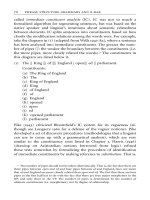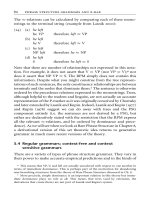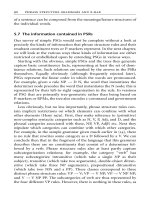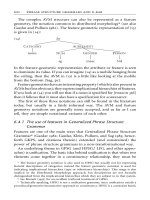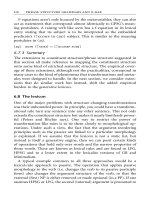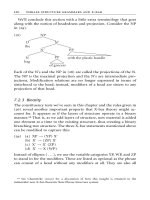Constituent Structure - Part 9
Bạn đang xem bản rút gọn của tài liệu. Xem và tải ngay bản đầy đủ của tài liệu tại đây (102.54 KB, 10 trang )
Within the Government and Binding (GB) and minimalist ap-
proaches to syntactic theory, NPs are licensed by structural Case,
which is assigned under a local version of c-command (government;
see section 4.3) by some particular node. This is one of the primary
motivations for Aoun and Sportiche to introduce m-command. Nom-
inative case is assigned by InX in the conWguration in (34a); genitive
case, by a noun in the conWguration in (34b).
() (a) IP (b) NP
NP I
Ј
NP N
Ј
NOM
Infl
VP
GEN
N
PP
If Case licensing does indeed occur under a c-command-like structural
relation, then clearly m-command is most appropriate. In the trees in
(34) the case assigning node m-commands—but does not c-command—
the NP it assigns case to.
4.2.5 Barker and Pullum: A unified approach to command
relations
Barker and Pullum (1990)12
;
13 oVer an important contribution to our
understanding of command relations and their underlying similarities
and diVerences. They observe that many of the deWnitions like those
given above of command are vague and imprecise (such as what
precisely is meant by ‘‘Wrst’’ in Wrst branching node). They provide a
uniWed account of all command relationships, and precise typology of
the various kinds of command relationships.
Barker and Pullum deWne all command relationships in terms of
various kinds of ‘‘upper bounds’’ in terms of various relationships or
properties.14
12 For a detailed discussion of the mathematical properties of Barker and Pullum’s
proposal, see Kracht (1993).
13 In addition, Barker and Pullum also observe a number of formal properties of
command relations, including the interrelationships between various kinds of command.
See the original work for details.
14 Note that Barker and Pullum’s deWnitions do not include the neither/nor condition
discussed in section 4.5.3. They claim to see no empirical reason for it. They do not discuss
the i-within-i facts. It is a relatively minor change to Wx their deWnitions so that it includes
this condition.
60 preliminaries
(35) The set of upper bounds for a with respect to a property P (writ-
ten UB(a, P)) is given by UB(a, P) ¼ {b j b /
þ
a & P(b) }
That is, some node b is an upper bound for a,ifb properly dominates
a, and satisWes property P. Most command relationships actually refer
to the minimal upper bounds (MUB):
(36) MUB(a, P) ¼{bj b 2 UB(a, P) & 8x[(x2 UB(a, P) & b /*x)
! (b ¼ x)] }
(This is an antisymmetricity requirement: b is a minimal upper bound
for a if b is an upper bound for a satisfying P, and if for all nodes x that
are upper bounds for a,ifb (reXexively) dominates x, then b is
identical to x.) As such, command relations will be deWned in terms
of types of relationships between that node and some (minimal)
dominator of that node.
Command relations are deWned as pairs of nodes, both of which are
dominated by the same upper bounds relative to some property P:
(37)C
P
¼ { <a, b>: 8x [(x 2 MUB(a, P)) ! x /*b]}
The command domain of some node a is the set of nodes with which it
is paired, relative to some MUB as deWned by property P. What is left to
deWne is the nature of the property P. This will vary depending upon
the type of command relationship that is involved.
Langacker’s command is deWned in terms of S nodes. So the deWning
relation is:
(38) S-command is the command relation C
P1
, where P1 is given by:
P1 ¼ {a j label(a) ¼ S}
Although no one has ever limited command to the NP node, Barker
and Pullum state the equivalent relation deWned in terms of NPs for
completeness sake:
(39) NP-command is the command relation C
P2
,whereP2 is given by:
P2 ¼ {a j label(a) ¼ NP}
Lasnik’s kommand is the combination of S-command and NP-command:
(40) K-command is the command relation C
P3
, where P3 is given by:
P3 ¼ {a j label(a) 2 {S, NP} }
M-command (Barker and Pullum’s max-command) assumes the
existence of the set max, which is the set of XP categories.
c-command and government 61
(41) M-command is the command relation C
P4
, where P4 is given by:
P4 ¼ {a j label(a) 2 max}
Reinhart’s original deWnition of c-command referenced branching
nodes, rather than labeled nodes. Barker and Pullum’s deWnition of
branching is rather involved. In order to describe branching, one has to
reference a treelet—that is, a structure consisting of a mother node and
at least two distinct daughters. The mother in this treelet does not have
to be the immediate dominator of the c-commanding node, but it
does have to reference immediate domination in order to establish
the branching relation. Barker and Pullum’s deWnition of immediate
dominance (M for mothership) is given in (42):
(42)M¼ {<a, b> j (a /*b)&:9x[a/*x/*b]}
(a dominates b, and there is no node x, such that a dominates
x and x dominates b).
Branching is deWned in the relation P5, where the dominator must be
the mother of two distinct nodes:
(43) C-command is the command relation C
P5
, where P5 is given by:
P5 ¼ {a j:9xy [x 6¼ y & M(a, x) & M(a, y)]}
Note that neither x nor y here must be the c-commander or
c-commandee. The node a need not immediately dominate these
nodes (although it must dominate them), however, a must immedi-
ately dominate x and y, which themselves dominate (potentially reXex-
ively) the c-commander and the c-commandee. Note, however, that
while c-command is frequently deWned in terms of branching nodes,
most scholars do not, in practice, require binary (or n-ary) branching.
This intuition is captured in the informal deWnition of c-command
given in section 4.2.1.
Barker and Pullum provide an alternative deWnition based on dom-
inating node, not necessarily branching ones. This is the relationship
that Emonds calls ‘‘minimal c-command’’, and is actually the most
frequent usage in the literature (although it is the least common
deWnition). Barker and Pullum call this IDC-command (immediate
dominance c-command).
(44) IDC-command is the command relation C
P6
,whereP6 is given by:
P6 ¼ N (N the set of nodes)
This corresponds to our deWnition in (23).
62 preliminaries
4.3 Government
In Chapter 1, we provided local or immediate variants of the structural
relations of precedence and dominance. One interpretation of the term
‘‘government’’ provides the local variant of c-command. Government,
unsurprisingly, was the central notion in the Government and Binding
(GB) framework (Chomsky 1981). It was perhaps the most important
structural relation in that theory until the paradigm shift in Chomsk-
yan linguistics known as the Minimalist Program (MP), which started
in the early 1990s (however, a relation very similar to government has
re-emerged in the Phase-theoretic version of minimalism (Chomsky
2000, 2001, 2004a, b)).
Somewhat confusingly, the term ‘‘govern’’ really has two quite dis-
tinct usages in GB theory. The Wrst usage is as a structural relation
(essentially local c-command), the second usage is as a licensing
condition. In GB theory, all the nodes in a tree must be licensed in
order to surface. Licensing occurs when the licensor stands in a gov-
ernment relationship to the element needing licensing. For example,
an NP is licensed with Accusative Case, when it stands in a government
relationship with a tensed transitive verb (the licensor). In the GB
literature, the term ‘‘government’’ is thus used in two distinct (but
interrelated ways). We will be concerned here only with the struct-
ural relation usage, although the licensing relationships deWned
using the structural relation serve as the primary evidence for the
approach.
There are many deWnitions of government. I give a typical, but partly
incomplete deWnition:
(45) Government: A governs B iV
a) A c-commands B;
b) There is no X, such that A c-commands X and X c-commands B.
The workings of this deWnition can be seen in the trees in (46).
() (a)
D
b)
D
AC
AC
BE
XE
BF
c-command and government 63
A governs B in (46a) but not in (46b). The node X intervenes blocking
A’s government of B. The relevant question, of course, is what X is. X
can vary depending upon the type of licensing relationship.
This is the ‘‘minimality’’ approach to government (see Rizzi 1989); in
earlier versions of government, condition (b) of the deWnition was
given in terms of intervening ‘‘barrier’’ nodes, rather than intervening
potential c-commanders. The barrier nodes dominated the c-com-
manded node rather than c-commanded it. The diVerence between
the two has to do with whether a head can govern into the speciWer
of its complement (these notions will be explained in Ch. 7; for
a textbook treatment of such deWnitions, see ch. 2 of Haegeman or,
for a more formal deWnition, see Chomsky 1981).
In early versions of GB theory, X was usually deWned as either a
lexical head (giving the licensing relationships known variously as head
government, lexical government or theta government, depending on
the particular restrictions on X) or a co-indexed antecedent element
(known as antecedent government). Rizzi (1989) proposed that, for
Wller–gap dependencies (movement relationships) at least, the nature
of X was relativized to the type of relationship that held between the
Wller and the gap or trace. If the Wller and the gap were both heads, then
X would be a head. If the Wller and the gap were related by an argument
relationship (i.e. A-movement, such as NP raising) then X would be an
argument, and if the Wller and gap were related by an A-bar chain,
(such as wh-movement), then X is another A-bar element. For a survey
of the function of the government relation, see any good GB theory
textbook (such as Haegeman 1994 or Cowper 1992). For a discussion
of the formal properties of this relation (and how it is technically not
a c-command relation, narrowly construed) see Barker and Pullum
(1990).15
15 Their argument is as follows. They start with the assumption that all c-command
relationships have the property of ‘‘descent’’. That is, if a commands b then a commands b’s
descendants. Government by deWnition lacks this property, so according to Barker and
Pullum it is not really a command relationship. It seems to me that this is a matter of
terminology. The deWnitions of immediate relations (e.g. immediate domination) have
related properties. That is, if A immediately precedes B, then it does not immediately
precede B’s followers (although it does precede them). We would not want to say that
‘‘immediate’’ precedence is ‘‘really’’ precedence, just because it is not transitive; nor should
we say that government is not a command relation because it is deWned to be a local
relation, and does not obey descent. We just need to distinguish between the general
relation and the local one. We should also note that descent is a problem for any system
(like Chomsky’s Phase theory) that is strongly cyclic, since nodes in such a system are not
allowed to c-command into lower cycles.
64 preliminaries




